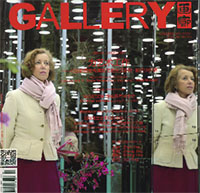Work Primarily for the Art: Interview with Dr. Beate Reifenscheid, Director of Ludwig Museum
 Read More: DOWNLOAD PDF
Read More: DOWNLOAD PDF
Editors Note: For this issues cover story, we have the honor to interview Dr. Beate Reifenscheid, the director of Ludwig Museum, for indepth exchange of views. She has traveled around the world, and her rich experiences, enthusiasm, and discipline forge the true spirit of a professional art manager. Born in 1961 in Gelsenkirchen, Germany, Beate studied at the Ruher-Universität Bochum, and Universidad Complutense de Madrid, and obtained a doctorate in 1988. She worked as a collections manager and contemporary art and media researcher in museums like Saarland Museum, Saarbrücken. As the director of Ludwig Museum, Koblenz since 1997, Beate has planned many important international contemporary art exhibitions.
Gallery: To Chinese Audiences of contemporary art Beate Reifencheid might still be an unfamiliar name, whereas to many art professionals in this country she is not. However, you have already participated in many activities in China, lets start with the story of how you got tied to our country. In 1996, the Ludwigs donated a great collection of modern and contemporary art works by many world-class artists to the National Art Museum of China. After that, this collection has been exhibited nationwide in a number of cities. I believe you should have, more or less, been involved in a few related events. Would you tell us a little bit about the Peter and Irene Ludwig Foundation as a whole?
Beate: This famous couple – Peter and Irene Ludwig – devoted all their lives to art. Both grew up in rich families, and especially Irene’s background was dominated by her family’s industrial production of chocolate. After their marriage Peter Ludwig was in charge of the chocolate production himself and managed to improve the whole process in fairly large scale, which enabled them to use the gained money for major acquisitions of art. They started in the early 1950s, and mainly focused on historical art positions, but with a wide range over the centuries and diverse cultural backgrounds. Thus they got involved into European medieval art, ancient Chinese ceramics and porcelains, Egyptian sculptures, important goldsmiths’ works from Renaissance and Baroque epochs, major paintings from Russian Expressionism ect. In the early 1960s they suddenly turned their interested towards contemporary art, especially to American Pop Art. That was also the initial for purchases that involved sometimes a whole sequence of works, or just the total exhibition at a gallery. The Ludwigs were suddenly known all over the continent and people got aware that private collectors started to dominate the states and idea of what Contemporary art may lead. During the decades their collection got so important and sophisticated that they needed to think about their storage, as well as starting to found new museums under their names.
